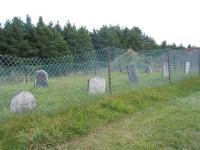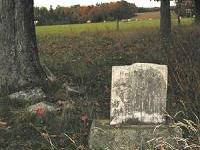 Like most people, I never paid much attention to cemeteries when I was young. I would see them alongside roads in travels with my parents and I knew that I had ancestors buried in some of them. But in general, cemeteries were places for kids to avoid. One only went there to visit the grave of a loved one or to attend the burial of a family member, neighbour or friend. Little did I know that one day I would visit and record just about every Protestant cemetery in Stanstead, Compton and Megantic counties and beyond.
Like most people, I never paid much attention to cemeteries when I was young. I would see them alongside roads in travels with my parents and I knew that I had ancestors buried in some of them. But in general, cemeteries were places for kids to avoid. One only went there to visit the grave of a loved one or to attend the burial of a family member, neighbour or friend. Little did I know that one day I would visit and record just about every Protestant cemetery in Stanstead, Compton and Megantic counties and beyond.
I was luckier than many people in that I became interested in family history while I was still a teenager. Many begin this fascinating pursuit later on in life, at a time when their parents or grandparents are no longer alive to pass on to them the family history. However, I knew from a young age that my grandmother -- and hence myself -- were descendants of Hannah Dustin, a famous New England heroine who escaped from her Abenaki captors back in the 1600s. I began to wonder how many other “famous” people I might be related to. I soon started looking at burial grounds in a different way. Tombstones and church records could offer important clues to the people buried beneath them. So, in my research I gleaned whatever information I could from the tombstones in cemeteries where my people were interred.
After the death of my granddaughter in 2002, I was visiting her grave in Huntingville Cemetery. Since I live nearby, I thought that it might be useful to have the names of everyone buried in the cemetery. So I took pen and paper and walked the entire cemetery writing down information from each stone as I went. I then entered the information into a database on my computer and uploaded it to an internet site called Interment.net, where cemetery records from different countries are stored and where they can be retrieved by anyone with access to a computer.
Soon after this, I visited Milby Cemetery with my wife Susan. We recorded the names, dates and other important information on all the headstones there and placed them on-line. Sometimes, additional information, such as military service or place of birth, is included on the monuments, providing family members with important details for their research.
I recall one burial ground -- the Rose Cemetery near Stanstead -- where the tombstone of one Eleazer Allbee, who was born in Vermont in 1785 and who died in 1864, has the following inscription: “He went into voluntary banishment from his beloved native country during the reign of terror in the third year of the misrule of Abraham the first.”
 As time went on we visited more and more Protestant cemeteries in Compton and Stanstead and ventured further outward to Sherbrooke, Frontenac, Megantic, Wolfe, Richmond and Drummond Counties. We have received many thank you emails (and requests to do other cemeteries) from people near and far who have appreciated our efforts and who have found some elusive ancestor’s name among the records that we have placed on-line.
As time went on we visited more and more Protestant cemeteries in Compton and Stanstead and ventured further outward to Sherbrooke, Frontenac, Megantic, Wolfe, Richmond and Drummond Counties. We have received many thank you emails (and requests to do other cemeteries) from people near and far who have appreciated our efforts and who have found some elusive ancestor’s name among the records that we have placed on-line.
So, what started as a small project to record the names of people in local cemeteries for my own use, and as a way of having a record at home without having to go to a historical society or library, has grown into an enriching hobby that has seen my wife and I visit, record and place on-line over 150 cemeteries in the Eastern Townships alone. We have visited and recorded everything from small family burial grounds with just one stone to sprawling cemeteries with over 6,000 burials. And now we have begun to document the Catholic cemeteries, as well. We even make an effort to visit cemeteries when we travel and we now have recorded graveyards in five provinces and six states.
Walking through old burial grounds is a trip back in time. One can imagine the struggles of pioneer families trying to survive two centuries ago in a land that was basically an unbroken wilderness. It is not hard to find evidence of the diseases and hardships that claimed the lives of many young children in the 1800s. The small gravestones erected in memory of those beloved children that appear in almost every old cemetery -- often with members of the same family lined up side by side -- attest to the fact that life at that time was not easy and that any family could expect that at some point someone would succumb to an early grave.
Travelling around the Eastern Townships finding and documenting these scattered cemeteries has given us a lot of pleasure, and this despite the high gasoline prices, mosquito bites and other distractions. We have learned a great deal from these treks and when the snow has gone and the warm weather returns you will likely find us out among the gravestones once again.
*Leslie Nutbrown is a retired teacher. He is the author of the book The Descendants of Thomas Nutbrown, published in 2000.